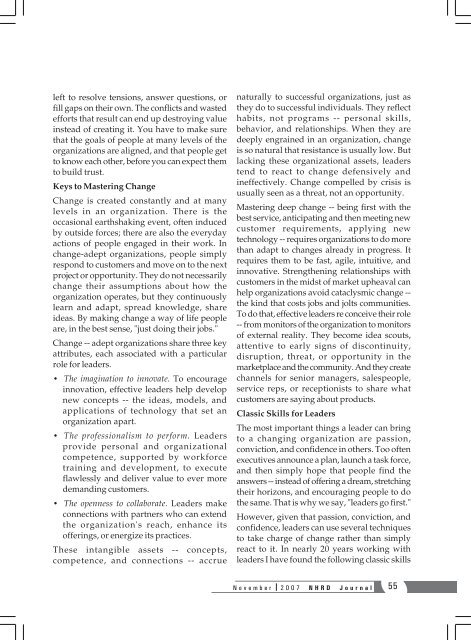NHRD Journal - National HRD Network
NHRD Journal - National HRD Network
NHRD Journal - National HRD Network
Create successful ePaper yourself
Turn your PDF publications into a flip-book with our unique Google optimized e-Paper software.
left to resolve tensions, answer questions, or<br />
fill gaps on their own. The conflicts and wasted<br />
efforts that result can end up destroying value<br />
instead of creating it. You have to make sure<br />
that the goals of people at many levels of the<br />
organizations are aligned, and that people get<br />
to know each other, before you can expect them<br />
to build trust.<br />
Keys to Mastering Change<br />
Change is created constantly and at many<br />
levels in an organization. There is the<br />
occasional earthshaking event, often induced<br />
by outside forces; there are also the everyday<br />
actions of people engaged in their work. In<br />
change-adept organizations, people simply<br />
respond to customers and move on to the next<br />
project or opportunity. They do not necessarily<br />
change their assumptions about how the<br />
organization operates, but they continuously<br />
learn and adapt, spread knowledge, share<br />
ideas. By making change a way of life people<br />
are, in the best sense, "just doing their jobs."<br />
Change -- adept organizations share three key<br />
attributes, each associated with a particular<br />
role for leaders.<br />
• The imagination to innovate. To encourage<br />
innovation, effective leaders help develop<br />
new concepts -- the ideas, models, and<br />
applications of technology that set an<br />
organization apart.<br />
• The professionalism to perform. Leaders<br />
provide personal and organizational<br />
competence, supported by workforce<br />
training and development, to execute<br />
flawlessly and deliver value to ever more<br />
demanding customers.<br />
• The openness to collaborate. Leaders make<br />
connections with partners who can extend<br />
the organization's reach, enhance its<br />
offerings, or energize its practices.<br />
These intangible assets -- concepts,<br />
competence, and connections -- accrue<br />
naturally to successful organizations, just as<br />
they do to successful individuals. They reflect<br />
habits, not programs -- personal skills,<br />
behavior, and relationships. When they are<br />
deeply engrained in an organization, change<br />
is so natural that resistance is usually low. But<br />
lacking these organizational assets, leaders<br />
tend to react to change defensively and<br />
ineffectively. Change compelled by crisis is<br />
usually seen as a threat, not an opportunity.<br />
Mastering deep change -- being first with the<br />
best service, anticipating and then meeting new<br />
customer requirements, applying new<br />
technology -- requires organizations to do more<br />
than adapt to changes already in progress. It<br />
requires them to be fast, agile, intuitive, and<br />
innovative. Strengthening relationships with<br />
customers in the midst of market upheaval can<br />
help organizations avoid cataclysmic change --<br />
the kind that costs jobs and jolts communities.<br />
To do that, effective leaders re conceive their role<br />
-- from monitors of the organization to monitors<br />
of external reality. They become idea scouts,<br />
attentive to early signs of discontinuity,<br />
disruption, threat, or opportunity in the<br />
marketplace and the community. And they create<br />
channels for senior managers, salespeople,<br />
service reps, or receptionists to share what<br />
customers are saying about products.<br />
Classic Skills for Leaders<br />
The most important things a leader can bring<br />
to a changing organization are passion,<br />
conviction, and confidence in others. Too often<br />
executives announce a plan, launch a task force,<br />
and then simply hope that people find the<br />
answers -- instead of offering a dream, stretching<br />
their horizons, and encouraging people to do<br />
the same. That is why we say, "leaders go first."<br />
However, given that passion, conviction, and<br />
confidence, leaders can use several techniques<br />
to take charge of change rather than simply<br />
react to it. In nearly 20 years working with<br />
leaders I have found the following classic skills<br />
November 2007 <strong>N<strong>HRD</strong></strong> <strong>Journal</strong> 55
















